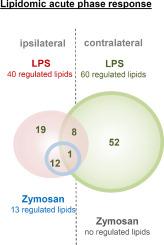Biochimica et Biophysica Acta (BBA) - Molecular and Cell Biology of Lipids ( IF 3.9 ) Pub Date : 2020-10-01 , DOI: 10.1016/j.bbalip.2020.158822 Lisa Hahnefeld , Lisa Kornstädt , Daniel Kratz , Nerea Ferreirós , Gerd Geisslinger , Sandra Pierre , Klaus Scholich

|
Toll-like receptors (TLR) are crucial for recognizing bacterial, viral or fungal pathogens and to orchestrate the appropriate immune response. The widely expressed TLR2 and TLR4 differentially recognize various pathogens to initiate partly overlapping immune cascades. To better understand the physiological consequences of both immune responses, we performed comparative lipidomic analyses of local paw inflammation in mice induced by the TLR2 and TLR4 agonists, zymosan and lipopolysaccharide (LPS), respectively, which are commonly used in models for inflammation and inflammatory pain. Doses for both agonists were chosen to cause mechanical hypersensitivity with identical strength and duration. Lipidomic analysis showed 5 h after LPS or zymosan injection in both models an increase of ether-phosphatidylcholines (PC O) and their corresponding lyso species with additional lipids being increased only in response to LPS. However, zymosan induced stronger immune cell recruitment and edema formation as compared to LPS. Importantly, only in LPS-induced inflammation the lipid profile in the contralateral paw was altered. Fittingly, the plasma level of various cytokines and chemokines, including IL-1β and IL-6, were significantly increased only in LPS-treated mice. Accordingly LPS induced distinct changes in the lipid profiles of ipsilateral and contralateral paws. Here, oxydized fatty acids, phosphatidylcholines and phosphatidylethanolamines were uniquely upregulated on the contralateral side. Thus, both models cause increased levels of PC O and lyso-PC O lipids at the site of inflammation pointing at a common role in inflammation. Also, LPS initiates systemic changes, which can be detected by changes in the lipid profiles.
中文翻译:

局部炎症模型的脂质组学分析显示对脂多糖的特异性全身急性期反应
Toll样受体(TLR)对于识别细菌,病毒或真菌病原体以及协调适当的免疫反应至关重要。广泛表达的TLR2和TLR4差异识别各种病原体,以启动部分重叠的免疫级联反应。为了更好地了解这两种免疫反应的生理后果,我们对TLR2和TLR4激动剂,酵母聚糖和脂多糖(LPS)分别诱导了小鼠局部爪炎症的脂质组学进行了比较脂质分析,它们通常用于炎症和炎性疼痛模型。选择两种激动剂的剂量以引起相同强度和持续时间的机械性超敏反应。脂质组学分析表明,在两种模型中,LPS或酵母聚糖注射后5 h,醚-磷脂酰胆碱(PC O)及其相应的溶菌种均增加,而仅对LPS响应的脂质增加。然而,与LPS相比,酵母聚糖诱导更强的免疫细胞募集和水肿形成。重要的是,仅在LPS引起的炎症中,对侧爪中的脂质分布才会改变。合适地,仅在经LPS治疗的小鼠中,包括IL-1β和IL-6在内的各种细胞因子和趋化因子的血浆水平显着增加。因此,LPS引起同侧和对侧爪子脂质分布的明显变化。在这里,含氧脂肪酸,磷脂酰胆碱和磷脂酰乙醇胺在对侧独特地被上调。从而,两种模型均在炎症部位引起PC O和溶血PC O脂质水平升高,表明在炎症中起共同作用。同样,LPS引发全身性变化,可以通过脂质分布的变化来检测。











































 京公网安备 11010802027423号
京公网安备 11010802027423号